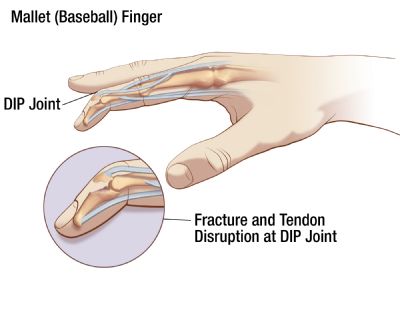Mallet Finger
Mallet finger is a condition where the extensor tendon that lifts the end joint (DIP) of a finger is detached, or avulsed, from the bone causing the tip of the finger to droop. It is also know by several other names including baseball finger and dropped finger. It frequently occurs when a person is attempting to catch a ball, such as a baseball or basketball and inadvertently hits the tip of the finger resulting in a ruptured extensor tendon. Usually a small piece of bone is still attached to the end of the tendon. It can also happen in a less dramatic fashion, such as reaching into a drawer or putting on a shoe, and it may be painless. This can lead to a Mallet injury going untreated for a long period.
Treatment
Treatment most commonly involves putting the finger in a Mallet splint, sometimes called a Stax splint, to keep the finger fully extended for 6 to 8 weeks. The splint allows the tendon to re-adhere to the bone. It is vital that the splint is worn around the clock to keep the finger from bending. One incident of bending the finger during this healing period can result in the tendon detaching again and the healing process must start all over again.
Some surgeons will provide a basic aluminum splint and refer patients to a Hand Therapist for a custom splint. These are made on the patient and, therefore, should fit more precisely. As the splint is worn for several weeks a correct, comfortable fit is important.
Surgery
Sometimes surgery is required to reattach the tendon. This course of treatment is frequently chosen when the Mallet finger presents as an open injury or if the bone that is avulsed is more than 30% of the articular surface of the joint. In some cases a K wire is inserted to keep the finger in full extension during the healing phase.
Therapy
Once the splint is removed the patient may be referred to Hand Therapy. This is done to restore maximal motion and function in a structured setting. There is a risk of re-injury if the patient is too aggressive and a risk of permanent stiffness if too cautious. The therapist will monitor the finger for a lag or droop which can indicate that the tendon is not adequately healed or the patient is working too aggressively.
While it may seem like a trivial injury, a Mallet finger that does not recover fully is more likely to be re-injured in the future as the posture of the affected finger may continually put it in harms way, particularly during ball games.
If you have questions about Mallet injuries or anything related to Hand Therapy please do not hesitate to call or e mail us.












